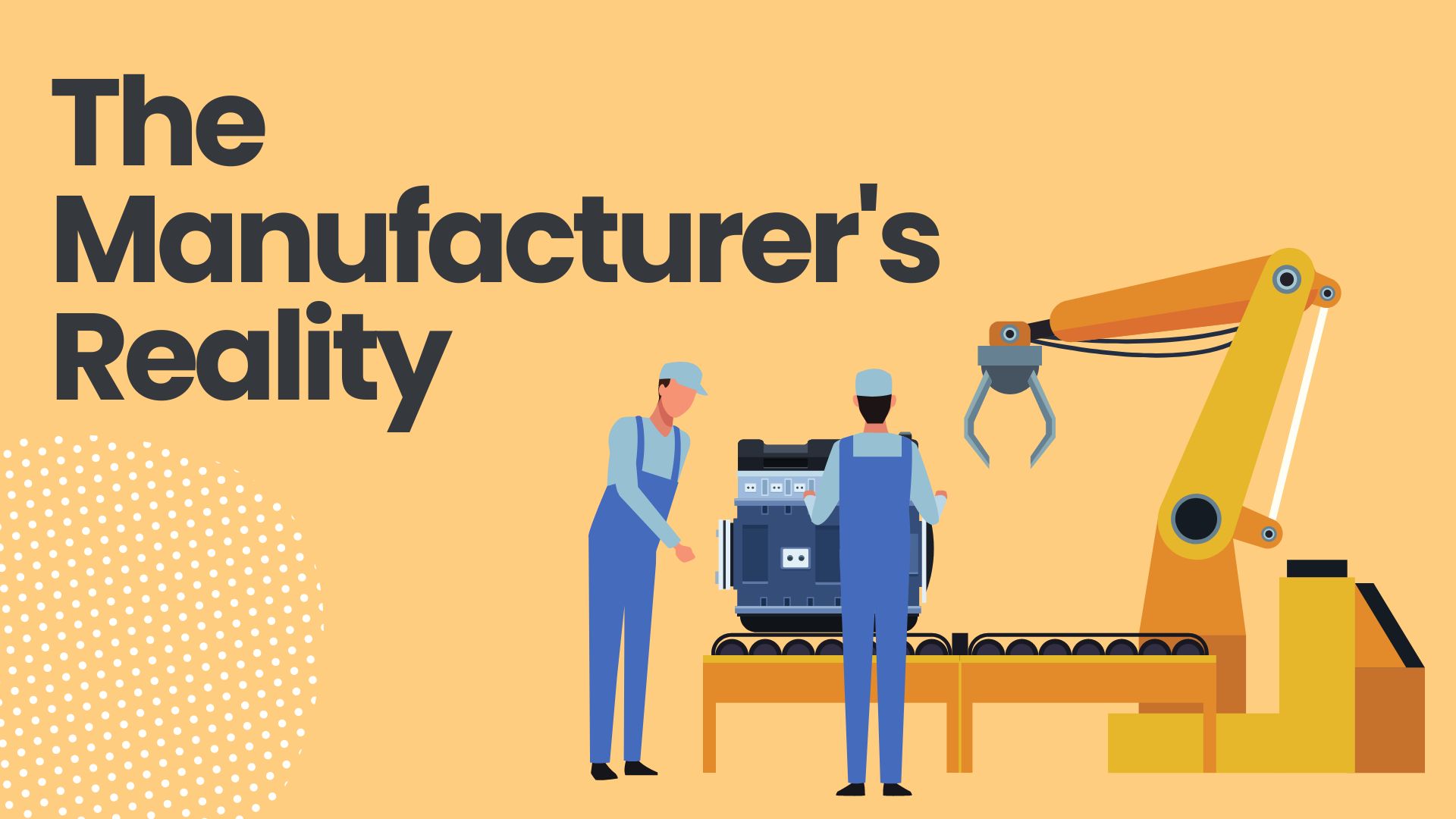A company footprint encompasses the overall environmental impact of an organization’s operations. While a product footprint focuses on the environmental impact of a specific product throughout its lifecycle.
As sustainability becomes an urgent priority, these concepts are increasingly intertwined. Every decision made at the company level directly influences the environmental profile of the products manufactured. Conversely, product design choices ripple back through the entire manufacturing process. This intricate relationship means that, for manufacturers, the company footprint is inextricably linked to the product footprint.
Understanding how these connect helps create better sustainability strategies. It addresses environmental challenges and meets demands for responsible production. Read on to learn more.
Product vs company footprints in sustainable manufacturing
A product footprint focuses on the environmental impact, carbon footprint included, of a specific product throughout its lifecycle–from raw material extraction to manufacturing, distribution, use, and disposal.
A company footprint is the overall environmental impact of an organization’s operations. It’s every light bulb, every truck, every scrap of paper your business uses. Encompassing everything from office energy use to manufacturing processes and transportation.
The impact of the products you create is an integral part of your company’s total environmental impact.
For example, an electronics manufacturer’s company footprint includes the energy used in their factories, while their product footprint includes the emissions from the devices they produce throughout their lifecycle.
Or a headphone maker considering whether to use recycled plastics or more efficient batteries, choices that affect both their company footprint (responsible resource use) and product footprint (sustainable materials and energy efficiency in the final product).
Headphone brand Skullcandy demonstrates this dual approach: they reduced their company footprint by making their packaging 100% recyclable and 20% smaller, lowering shipping impacts. Simultaneously, they improved their product footprint by developing wireless earbuds with more efficient batteries, decreasing the footprint of individual products.
Ultimately, more efficient operations lead to more sustainable products.
Disconnect between company and product footprints
Many manufacturers treat company and product footprints as separate entities. This is often because of organizational structure; the sustainability team is focusing on overall company metrics, while product development teams concentrate on individual item specifications.
Why? This disconnect often stems from:
- Siloed departments: Sustainability teams and product developers are working independently.
- System chaos: Separate tracking and reporting mechanisms for company-wide and product-specific environmental data.
- Regulation roulette: Company-level emissions might be regulated differently from product-specific environmental standards.
This can create a headache for corporate sustainability efforts: causing inconsistent sustainability strategies, duplicated efforts in data collection and reporting, and missed opportunities for holistic improvement.
An electronics manufacturer’s sustainability team might work to reduce energy consumption. Meanwhile, the product team focuses on creating energy-efficient devices. Without proper alignment, they might miss the opportunity to use energy-efficient manufacturing processes (company footprint) to create even more energy-efficient products (product footprint). This disconnect could lead to poor resource allocation and uncoordinated sustainability efforts.
Impact of company and product footprint misalignment:
The misalignment between company and product footprints can have far-reaching consequences. From financial and environmental impact to regulatory risks and reputation damage, such as:
- Environmental impact: Higher overall emissions despite eco-friendly product designs or overuse of raw materials and energy, negating product-level gains.
- Regulatory risks: Overlooking company-wide or product-specific environmental regulations or risking financial penalties for non-compliance.
- Financial consequences: Increased operational costs because of inefficient resource use or missed opportunities for cost savings through sustainable practices.
- Reputational damage: Loss of consumer trust due to inconsistent environmental claims or reduced market share in an increasingly eco-conscious market.
- Missed opportunities: Risk of falling behind competitors who successfully integrate sustainability efforts or a lack of innovation in addressing company and product sustainability.
By treating company and product footprints as interdependent, manufacturers can avoid these pitfalls. Improving their environmental performance, reducing risks, cutting costs, enhancing their reputation, and gaining a competitive edge.
Solutions to company and product footprint misalignment
While it’s common for manufacturers to consider company and product footprints separately, the key is to recognize the critical importance of product footprinting in overall sustainability efforts.
By focusing on product environmental impacts, companies can make significant strides in reducing their overall ecological footprint. Here are strategies that manufacturers can implement to enhance their product footprinting and sustainability initiatives:
Conduct a comprehensive Life Cycle Assessment:
To address the interconnection between company and product footprints, manufacturers should conduct product carbon footprinting using life cycle assessment (LCA) methodology. This approach provides a focused yet comprehensive understanding of the climate impact of specific products.
Product carbon footprinting using LCA methodology offers a systematic analysis of emissions across the entire value chain, from raw material extraction to end-of-life disposal. This holistic approach enables manufacturers to identify key areas for carbon reduction in both company operations and product design.
Companies can use carbon footprinting specialists or software that employ LCA methodology to analyze emissions at each stage of a product’s life cycle. This process pinpoints carbon hotspots, informs ecodesign decisions, and provides a solid baseline for measuring improvements.
This product-centric approach to carbon footprinting, grounded in LCA methodology, aligns with consumer demands for climate-friendly goods and can drive innovation in product development and manufacturing processes. It offers a robust framework for understanding and reducing carbon impacts, while also providing the foundation for more comprehensive environmental assessments in the future.
Integrate sustainability practices across all operations:
Next, manufacturers should consider implementing integrated sustainability practices across all operations.
This involves developing and deploying sustainability initiatives that span all operational areas, ensuring coherence between company-wide efforts and product-specific enhancements.
By forming cross-functional teams to develop integrated sustainability strategies and KPIs, companies can eliminate silos, create alignment between departments, and maximize the efficiency of sustainability efforts.
Use software to track and report environmental data:
The use of technology and software solutions to track and report environmental data is crucial.
Advanced digital tools help companies monitor, analyze, and report data across the organization and product lines.
By selecting and deploying enterprise-level sustainability management systems that integrate with existing operational software, manufacturers can enable real-time monitoring, facilitate accurate environmental reporting, and support data-driven decision-making.
[btn link=”https://ecochain.com/mobius/” target=”_parent” type=”ghost” ]Ecochain Mobius[/btn]
Engage with stakeholders and suppliers for supply chain alignment:
Finally, engaging with stakeholders and suppliers can ensure alignment throughout the supply chain.
This involves actively involving both internal stakeholders and external suppliers in sustainability initiatives to extend environmental efforts beyond organizational boundaries.
Developing supplier sustainability programs, conducting regular stakeholder consultations, and establishing collaborative improvement targets drives system-wide improvements, ensures consistency in sustainability efforts, and strengthens relationships with key partners.
—
By implementing these solutions, manufacturers can effectively enhance their product footprinting practices while contributing to overall sustainability goals. This focused approach leads to improved environmental performance of individual products, better alignment with regulatory requirements, and a stronger competitive position in an increasingly sustainability-conscious market.
Ready to measure your product’s footprint? Ecochain Mobius is a product footprinting software based on LCA methodology helps you:
- Make informed decisions about your products’ environmental impact,
- Improve your sustainability performance,
- Achieve your sustainable manufacturing goals.
[cta cta_id=”3171″]

